Vampire: the Masquerade 5th Edition won the Origins Awards for Best RPG as well as the fan award. I’m very happy about this. Origins attributes V5 to Modiphius but the original three books of the game were created in-house at White Wolf, before White Wolf was subsumed into its parent company of Paradox Entertainment.
I wrote most of the Anarch book as well as some material for both the core and Camarilla books. I figured it might be interesting to go through some of the chapters I did for Anarch and the creative and design decisions involved.
I’ll write about parts I created here. The rest is mostly the work of Matthew Dawkins, who was wonderful to work with because of his immense knowledge of Vampire.
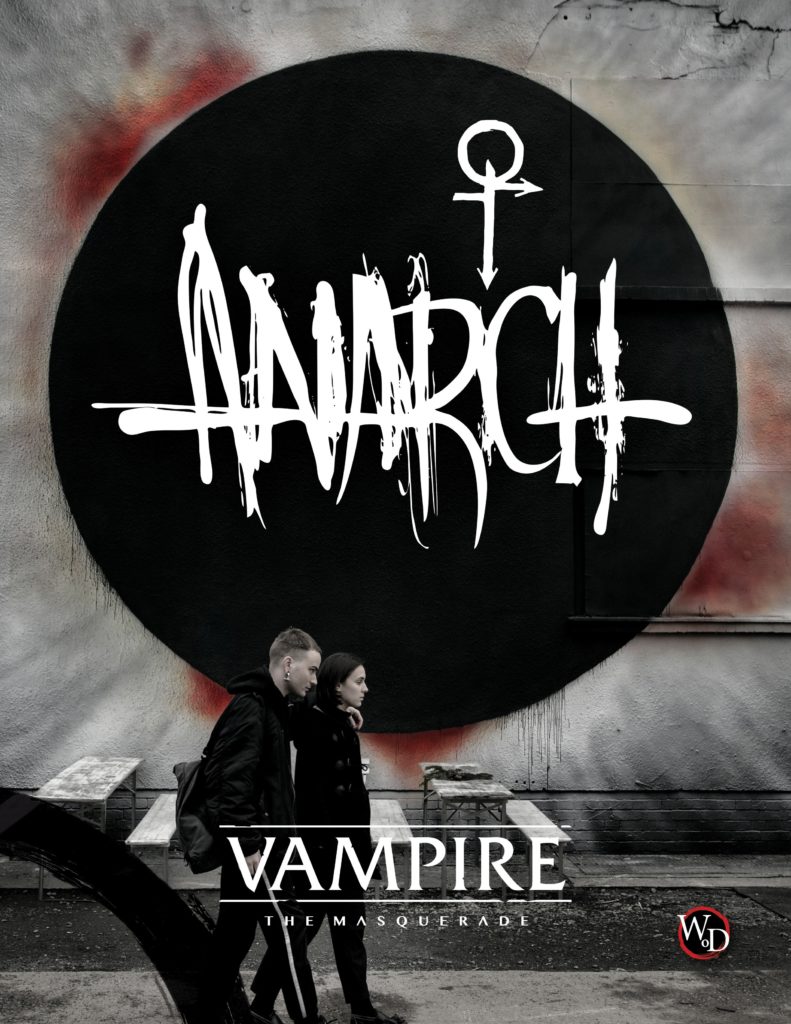
Goal
I wanted to write an entertaining, readable, engaging book. It’s purpose was to explore the V5 Anarch idea of vampires living enmeshed in human communities as well as give ideas and prompts people could use in their own games.
Because Anarchs don’t live apart from humanity like the Camarilla does, Anarch characters, groups and concepts must necessarily connect closely to human experience. Because of this, I sought to bring the material in the book closer to reality than has been customary in the World of Darkness.
In this, I followed the style of my Vampire larp work, especially in Parliament of Shadows. It was a Vampire larp I did with Maria Pettersson and Bjarke Pedersen, played in 2017, about how the Camarilla wields its political power in concrete terms. It was played partially in the real European Parliament and featured two actual MEPs playing themselves.

In earlier editions, the Camarilla, the Anarchs and the Sabbat have been the main three factions of the vampire world, with the Ashirra maintaining a presence as well. When you read older Vampire books, the Camarilla and the Sabbat come across as strong and distinctive while the Anarchs remain more marginal and the Ashirra a side note.
Since in V5 the main focus is initially on the Camarilla and the Anarchs as the two sects that define the setting I took it as my task to give the Anarchs some punch. The revolution had to feel dangerous.
This was part of the wider project of developing Vampire’s setting to work better for the default character types of the game, meaning Neonate vampires. A resurgent Anarch movement fighting against young Camarilla Kindred who inherited the empires of their Elders is more dynamic than the stagnant setup of earlier editions.
I also wanted the revolutionary politics of the Anarchs to connect more to real-life revolutionary thinking. Reading older Anarch books, I often felt the Anarchs were portrayed as politically mild and ambitionless, beggars asking for crumbs form the table of the Camarilla. I tried to add some rigor.
I can’t really claim to be a political activist but I do believe I’m the only Anarch writer who has broken into a NATO airbase for the purpose of bringing attention to American nuclear weapons placed illegally in Belgium. (I wrote the very first article of my career as a journalist about that experience. It’s here.)
The last time there was a Nazi march in Helsinki on 6.12.2018, I ran five blocks alongside it yelling for them to fuck off. (I had to stop because I’d had dental surgery that morning and was bleeding from my mouth. Also there were Swedish Nazis there, and those guys are genuinely quite terrifying.)
I felt this small real life experience helped bring some new perspective into what the Anarchs can be in Vampire.
The content plan for the book was put together by V5 lead designer Kenneth Hite. My task was to make that plan into reality. This was a challenging task because of the wealth of both real-life material and Vampire lore referenced and I ended up doing a massive amount of research.
Chapters
The individual chapters in Anarch are short, often just a two-page spread. This was a blessing because it made it easier to avoid the verbose word bloat of so many roleplaying game books.
The plan was to make almost all of the book 100% in-game text, so prose style played an important part. I tried to vary this as much as possible to make it more interesting to read, so there are diary entries, chat logs, straight prose, manifestos, and so on.
All the examples from the Anarch book are from the original version, not the current redacted Modiphius version, unless otherwise noted. You can check the differences between the versions here.
Introduction
When I first got into Vampire in the mid-Nineties, I paid close attention to the song lyrics quoted in the books. I literally took down the names of bands and went to the record store to buy the albums. I found a lot of great music this way.
However, there was one quote which I has unable to place, although I tried. That’s the one on the back cover of the first edition of the Vampire corebook:
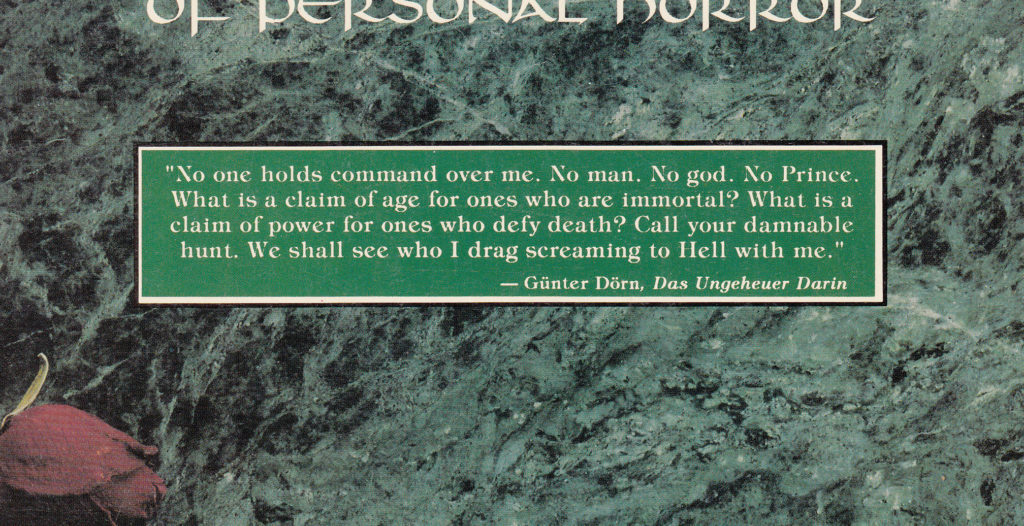
Given that my task was to rescue the Anarchs from mildness, I was very happy that the very first Vampire book was defined by such an Anarch-appropriate quote!
That’s why I had to include it in the Introduction to my Anarch book:

What Are We
This chapter presents a collection of jumbled, weird ideas of what being a vampire might mean. In Vampire: the Masquerade, there’s a well established mythology where Caine was the first vampire, cursed by God to wander the night. However, because Anarchs are often disconnected from vampire traditions, they make up their own explanations instead, some of them bizarre.
This is one:
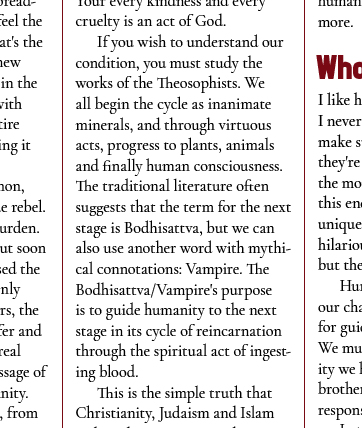
In my family we had a woman called The Aunt, an important figure in my childhood. She was an ardent Christosophist. Christosophy is an offshoot of Theosophy. She tried to teach me some of her worldview and while it never quite stuck, echoes are now on the page of this Vampire book, although I don’t think she would approve of the vampiric insinuation.
Monsters of the Recent Past
Here Anarch activist Rudi talks about trying to understand vampire history. You may wish to apply these same ideas to your favorite news sources. Rudi is actually Gangrel. The mistake is mine.

The City On the Sea
The myth of Carthage is an integral part of the story of the Anarchs. This chapter represents a revisionist take on it, which I’m sure you noticed if you’ve read versions published in earlier Vampire books. The idea is to explore what happens when a modern Anarch vampire applies the idea quoted above under “Monsters of the Recent Past” to vampire history.
What does the history of Carthage look like when you assume it’s Ventrue propaganda?
I did some research into the real history of Carthage and it turns out there is some disagreement among historians about the reliability of the standard account of Carthaginians as terrible baby murderers. In this real-life analysis, the sources for the worst stories are Roman, and Rome was at war with Carthage. Traditionally through human history, lies have been told about enemies. Often accusing them of being baby murderers.
In this analysis, the explanation for why there are archaeological finds with concentrations of the remains of children in Carthage is that they are cemeteries, not ritual abattoirs.
I’m not enough of a historian to know what’s true, but I figured it would be interesting to couple this real-life disagreement about historical sources with the analyses of Anarchs seeking to make sense of their history.
Looking For Tyler
The Movement needs heroes, villains and celebrities, characters who define what it means to be an Anarch. I tried to use existing canon characters when possible, and some of those are pretty great.
One of them is Tyler, one of the very few Anarch Elders present from the time of the First Anarch Revolt. In this chapter, I tried to make her into a mythological figure, an Anarch saint who can appear everywhere and nowhere.
Since she has no Domain, no known philosophy, allies or affiliation beyond that of being the original Anarch you can project whatever dreams of revolution you want onto her. Just like people do with real symbolic figures!
Reign of Terror / ’68
When you read the history of Anarchs in older Vampire books, they sound kinda depressing. A lot of disappointments, not many victories. To me, this is not about the historical events but the emotional tenor of what it means to be an Anarch. I wanted there to be moments of glory in Anarcb history, times when being an Anarch was great.
These two chapters concerning the history of Paris offered a good opportunity for inserting a little revolutionary joy into the proceedings.

I went to art school in France in the mid 00’s. Some of these old men and women who’d experienced the glory days of ’68 were still around.
Personally, the closest I’ve ever gotten to this kind of joy was in my early twenties, around 2000. In Finland on Independence Day, the President hosts a reception for the national elite. This is a stodgy televised event where you can see generals and parliament members shake hands with the President in a long line.
At that time, there was a strong culture of protest around this event. The protest was known as “Kansan kuokkavierasjuhlat”, “The People’s Gatecrashing Party”, with activists trying to get the demonstration in front of the presidential palace and the police doing their best to keep them away.
These are some of the rowdiest demonstrations I’ve ever participated in. (Finnish demonstrations are usually pretty staid.) The police charging the crowds with shield walls, people running the streets to try to outflank the police cordons, arrests. However, the thing I remember best is the camaraderie and feeling of purpose in the crowd. It was not a somber crowd, there was energy despite the December cold and overwhelming police presence.
Being online is often a lonely experience, making you feel like you’re alone in a world of assholes and malign fools. Being physically part of a protest crowd has often made me feel the opposite of that, when I see all these different people around me, all with a united vision.
Of course, since this is a Vampire book and vampires poison everything, the joy of the Anarchs is not quite the same joy as what I experience in a protest.
Ten Nights That Shook the World
In old World of Darkness books, the focus of the setting is on the U.S., which makes sense because it was originally an American roleplaying game. Areas outside the U.S. were also featured, but often their treatment was sketchier. One area where this is particularly noticeable is Eastern Europe and the role of the Soviet Union in vampire history.
This is also reflected in who the game is for. In 1991 when Vampire first came out, Russian roleplayers didn’t have a lot of visibility in American roleplaying game circles. Today, Eastern European countries have large Vampire fanbases.
From where I live, it’s four hours by train to St. Petersburg, so for this reason also Russia is more of a real place to me than it was to early Nineties American roleplaying game writers.
One of the guidelines we had for Vampire 5th Edition was that when it comes to historical events, vampires are parasites riding the current of human events, not secret masters in control of everything. The motivations for this concept are twofold: To make vampires more parasitical and monstrous and to avoid shifting the blame for human horrors onto supernatural entities.
However, in terms of the vampire history of the Soviet Union, this creates a problem, because past books have asserted that a “Brujah Council” controlled the Soviet Union.
This chapter represents my attempt at squaring the circle. How to keep the canon intact while keeping the blame for the horrors of Soviet atrocities were it belongs?
My solution was to focus on the idea that in a totalitarian state, there might not be a big moral distinction between a human KGB boss or a vampire KBG boss. The idea is that the Soviet Brujah were young revolutionaries who became corrupted while the larger human structure around them stratified into a totalitarian state. They didn’t control the revolution or secretly cause it to happen, but just participated in it the same as ordinary humans. Afterwards, they floated to the top because as vampires, they were uniquely suited to survive in this new environment. Yet even then, they didn’t really define the system. They were just another power block among many.
This is the kind of problem you have with working on an established IP. It was important to me to respect the material that came before, but also try to reinterpret it so it would fit the new vision for how Vampire works.
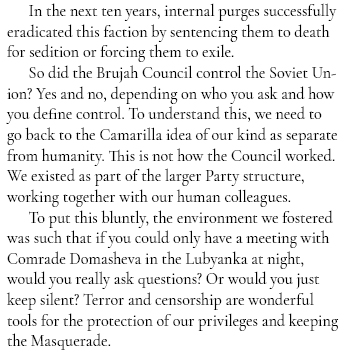
Dee’s Blood Guide to the Anarch Free States
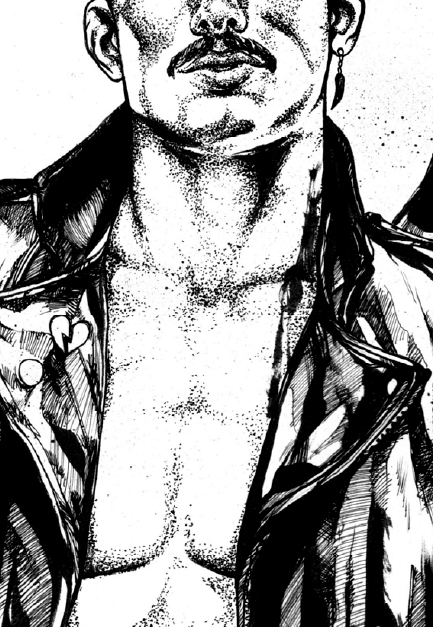
I read a lot of old Vampire books while I was writing Anarch. I noticed that while especially for an early Nineties roleplaying game Vampire had a lot of women in it, the trend where women are hot and men are cool was still present. For this reason, I wanted to put a little objectification of hot Anarch dudes into this book. In this chapter, it’s present in the text, but more importantly in the illustrations by the wonderful Jer Carolina. We talked about what would be the right look and the conclusion was to go full Tom of Finland.
Walk Among Us
Each new section of the book is introduced by a little dialogue about the themes of the following chapters. In these, I really tried to break away from the previous tradition of Vampire writing and make them light, engaging and contemporary.
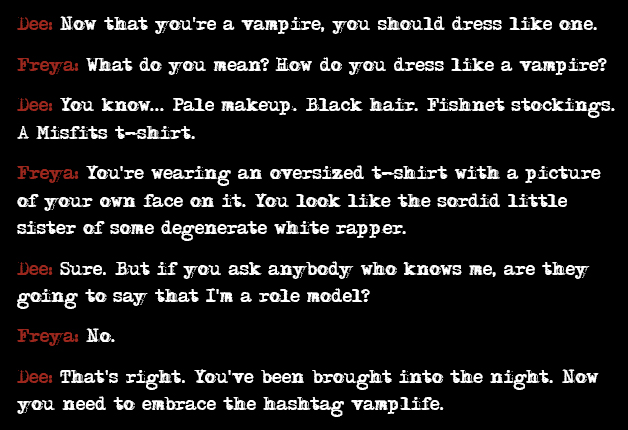
This exchange is a reference to Victor Pelevin’s excellent vampire novel Empire V. It has a wonderful moment where two vampires discuss what’s the appropriate way to dress now that you’re a vampire.
Enlightenment in Blood
In V5, the two core factions are the Camarilla and the Anarchs. To give the Anarchs a little more bite, in the new setting material the revolution got into full swing. To make this more concrete, one of the three most important Camarilla cities in Europe, Berlin, fell to the Anarchs in a bloody and chaotic insurrection. This meant that in V5, only Paris remained of the old pillars of the Camarilla. (London fell to the Second Inquisition.)
The Anarch revolution in Berlin was the subject of a major urban larp I did in 2017. It was produced by Participation Design Agency and created with the license and creative collaboration of White Wolf to integrate new setting ideas in advance of the publication of V5.
In Enlightenment in Blood the larp, the goal was to create a full-scale simulation of the revolution on the real streets of the actual city of Berlin. To make this happen, we had a dozen locations in the Friedrichshain area, including two nightclubs and a church.

This chapter in the Anarch book is a reflection of those same events, of the fall of the Camarilla and the messiness of revolution.
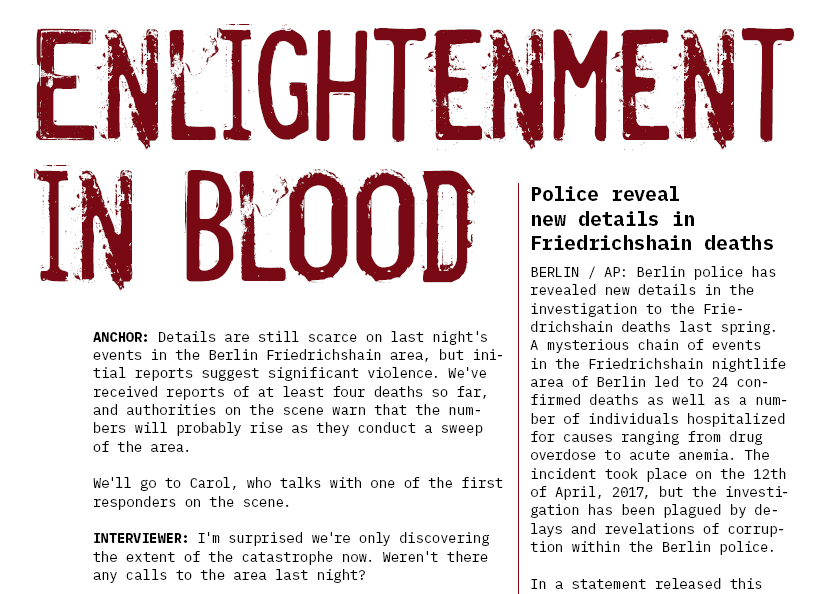
Dawn of Satan’s Millennium
In Kenneth Hite’s original plan for the Anarch book, this chapter was supposed to be about Norwegian black metal vampires. However, in Finland we also have an extremely strong metal scene, so I decided to locate the chapter closer to home.
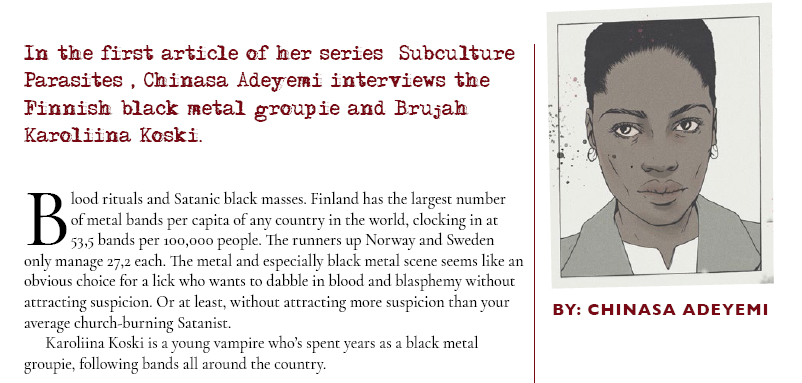
Much of the specific detail in the chapter is based on the documentary Loputon Gehennan liekki. You might think I made up some of the weirder details in the chapter, but think again…
In this chapter, I introduced the Anarch journalist character Chinasa Adeyemi. I have a background in journalism so I wanted to have a point-of.-view character through whom I could write a few different types of articles. Thus I made the Adeyemi chapters into approximations of Vice, the Economist and other styles. After all, a good journalist can adapt to the idiom of the publication.
The Night Circus
Here’s a fun biographical detail about me: I come from a circus family, in the sense that the circus was the family business for most of my life. My mother is a circus director and I’ve worked all kinds of odd jobs from selling popcorn to being a fireguard for when there’s a fire-based number.
The circus material in this chapter is entirely romanticized, though. The one true detail is when the trapeze artist plummets to the ground, and even it’s not really true. When I was in art school I directed an experimental circus performance which ended with the fall of the trapeze artist. The reference here is an echo of that.
Is It OK To Feed Vitae To a Baby?
In the plans for Anarchs in V5, there was an unusual focus on cleavers, vampires who try to retain a human existence to the point of raising families. Of course, this endeavor is doomed to end in tragedy. The reason for this attention on cleavers was to highlight the worse sides of Anarchs so as to avoid making them the “good guys” in a game that has no good guys.
I don’t have children myself so I immersed myself in Finnish baby forums and the style of discussion there. Based on that material, I wrote this chapter as a parody of those forums.
In the Anarch book, this has been the most polarizing thing I’ve written. Modiphius chose to censor it from the current version of the PDF they sell. I’ve also gotten more positive feedback about this than any other thing in the book. Most of these comments have come from parents.
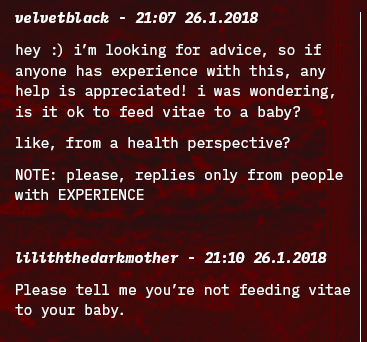
The cleaver theme was also explored in the chapter “Delusions of Humanity” (page 62), about a woman who became a vampire because she was hired as an au pair to a cleaver family.
Ni Dieu, Ni Maitre
The classic slogan in French. It’s also a reference to this:
I’ve been a fan of French hiphop ever since I found a couple of IAM albums from the Helsinki municipal library system when I was a teenager. I wanted to have a little of that in the book so I spent an inordinate amount of time figuring out the references in this chapter, tiny as they are.
The chapter is a lesbian love story between an Anarch and a Camarilla vampire. After reviewing the existing prominent Anarch canon characters, I made a policy decision to make almost all the new ones I created women, hopefully helping a little with the gender balance of the game’s setting.
The Ministry of Love
This is the last thing I wrote for the Anarch book, some time after I’d completed the main part of my writing task in the spring of 2018. It was during this time that bizarre rumors started to circulate on American roleplaying Twitter that Swedish Nazis were sending secret messages coded in the dice roll examples of Vampire playtest scenarios.
I found this quite insulting, and I wrote this chapter in that state of mind. As a result, it has two Ministry vampires talking about the pros and cons of using alt-right people as pawns:
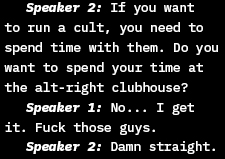
This same theme was explored more thoroughly in the chapter “Build a Better World (For You)” (page 112).
Whatever Happened to the Red Question?
Before this book, there were three setting books about the Anarchs for Vampire: Anarch Cookbook (1993), Guide to the Anarchs (2002) and Anarchs Unbound (2014). The city sourcebook Los Angeles By Night (1994) is also significant because it shows what Anarch ideas mean in practice.
Out of these books, the two early ones, Anarch Cookbook and Los Angeles By Night, informed my approach to the material most because in them, the Anarchs were more politically aggressive.
The last Anarch book before mine, Anarchs Unbound, moved the action from the streets to online, spending a lot of time on Anarch hackers who used their knowledge of modern networks to stymie archaic vampire Elders.
This is something where Vampire essentially did a U-turn when we came to the V5 edition. Instead of vampire hackers, online was suddenly the domain of the Second Inquisition hunting for undead to kill and capture.
In Anarchs Unbound, the vanguard of the vampire hackers is the group Red Question. I wanted to keep the setting material of Anarchs Unbounded as part of the new Anarch book but reinterpreted so it’s part of the Movement’s history. In this case, the Red Question now represents the heady days of online freedom before the Second Inquisition crackdown.
Another detail in this chapter is the question of responsibility for the 2008 financial crisis. The older book suggests that it was caused by Anarch vampires of the Red Question, but following the idea that human evil shouldn’t be ascribed to vampires, I muddied the waters:
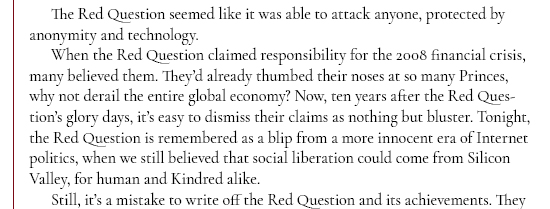
Revelations of the Dark Mother
For my money, Revelations of the Dark Mother (1998) is the best individual book published for the first three editions of Vampire. I always felt it was a shame it’s ideas were not really integrated into the rest of the vampire line except in a sporadic, scattershot fashion.
To me, it seemed obvious that the religious ideas of the Bahari would find a lot of adherents among the modern Anarch Movement. I tried to bring that out in this chapter.
Unfortunately I’m not entirely satisfied with my efforts. I don’t think I quite managed to live up to the verve and style of the original book.
Still, I did my best:
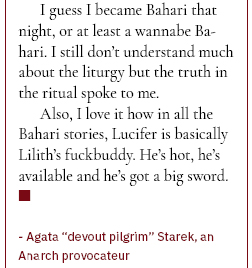
Rudi’s Army
This chapter features a group of Copenhagen vampires who are all young antifa types having the kind of semi-formalized activist meeting that I’ve also participated in a few times.
A lot of the basic energy of this chapter comes from the simple: “What would you do if you became a vampire?” -type questions. I mean, Nazis are scary because they can beat you up, but if you’re a vampire…
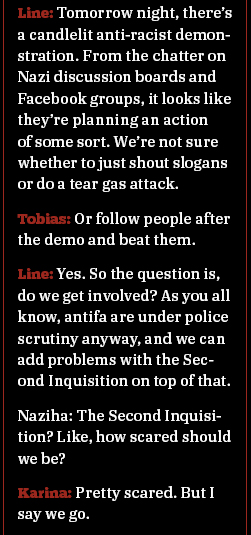
Electric Vitae Acid Test
This chapter is about using humor to combat the Camarilla. It was hit by censorship in the new versions of the PDFs. Check if you can see the difference:
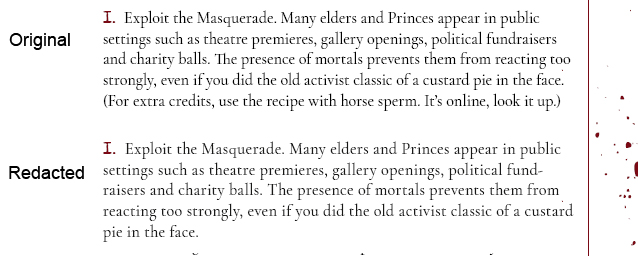
Eat the Rich!
This is a book with a lot of different characters speaking in their own voices, but two in particular define the dichotomies of the Anarch Movement: The ideologue Salvador Garcia (a classic canon character) and the killer Agata Starek (created by me).
Garcia wants to build the Movement into something sustainable, yet he’s stymied by the fact that vampires are destructive parasites. Agata Starek is a nihilistic destroyer who can’t create anything of lasting value, yet is very effective in making the Camarilla fear the Anarchs. When Salvador Garcia fails you, Agata Starek is there to destroy those who hurt you.
Both are also featured on Loresheets at the end of the book.
I put a lot of thought into the creation of Agata because I wanted her to fulfill a very specific role: To show the joy and terror of a vampire revolution. Agata is a rarity among vampires in the sense that she’s essentially a happy person, content to Diablerize Camarilla pretty boys while others do the work of keeping the Movement together.
I was also influenced by this article about the limits of female characters as positive role models. I wanted to make Agata into a terrifying wild cannon, a psycho who’s exploits are interesting to read about even though she’s beyond ordinary human morality.
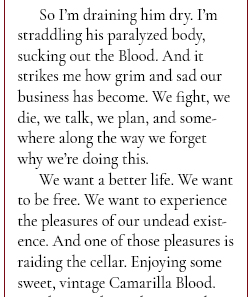
One thought on “Non-Digital: The Annotated Anarch”
Comments are closed.